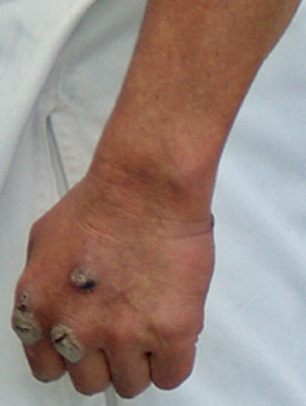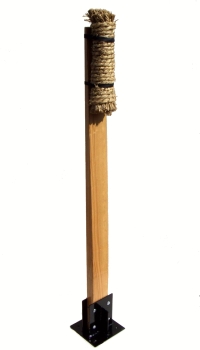THE IRON FIST OF THE MAKIWARA TRADITIONAL STRIKING POST by Hanshi Gibson ONE PUNCH ONE FINISH
Disclaimer: Makiwara training can be dangerous if undertaken incorrectly. Use only a properly built makiwara, performing all techniques under the guidance and supervision of a qualified instructor. The makiwara is an old traditional karate striking post used for focusing and correct technique. In my opinion it is a piece of equipment that should only be used by adult black belts who practice hard karate styles. The makiwara is mainly for developing hand techniques, seiken "forefist" and tegatana "knife-hand"although it may also be used for elbow, knee strikes and kicking.
For kicking techniques a more sturdy makiwara board should be used. The practitioner will find after many years of practice that it will eventually harden up the skin of their hands or feet that is used in the strikes i.e.: knuckles, side of hands, palm, elbow, ball, side or heel of foot. It will also enlarge the knuckle bone that is used in punching the makiwara. The makiwara has been used for centuries and is still used a lot in Okinawa and Japan by many karate masters and students alike. The purpose of makiwara is thought by many masters to be an important piece of equipment to the serious traditional karate-ka (student), although its also true to say that it is also frowned upon in the West and even by some Japanese. The lack of use of the makiwara is in the West where it seems to be non existent. The reason for this may be because we do not have many full time dojos (karate gyms), but the truth may be that the majority of karate people in the West have no idea at all about its history, use or its importance. Also the introduction of sport karate has not helped its cause where the main priority is of winning trophies and self image is favored over traditional training methods. Another reason for its dismissal and one which is very important is because it can produce thick hard calloused skin, bone deformities and damage nerves. For this very reason no one under 21 years old should never use the makiwara as it could cause long term injury. People who use the makiwara train at their own risk. In my own opinion, if the makiwara is used properly with correct hand strengthening exercises and without to much over-use, then, all you should get is a bit of hard calloused skin. A good skin liniment like Dit Da Jow before and after training should help in keeping the hand and skin supple. What the makiwara does for the karate-ka, and I think this is important why it should be used It gives the correct delivery of the punch by training the karate student to use a proper hip twist as well as the training in balance shifting when striking. It also teaches one more very important factor, in that by constant punching the small target area on the post gives you pin point accuracy. I myself have developed through many years of makiwara training many other ways to take this to a another level. From many years of practice the fist should eventually mould into a strong hammer like weapon. Makiwara training also teaches you to strike the post with the first two largest and strongest knuckles of the fist which is the method for punching in karate. The middle knuckle should be in line with the center of the wrist, do not bend the fist downwards or upwards but keep it flat and level so the force is transmitted in a straight line. Power comes from the hip twist and the rebound energy from the floor up through the body and down the arm to the point of impact. Below we see the effect of very heavy use on the Makiwara Calloused knuckles from extensive makiwara training
A traditional makiwara is usually a tapered piece of spring wood with around 5 to 6inches of play when hit. The ones that you get in the shops that hangs on the wall is not that good as I feel it is to static with the rebound being slightly limited. Over a long period I believe you could do damage to the bones and joints. Although I did practice myself on one of these wall makiwara's but I only practiced roundhouse kicks with the ball of the foot which to me was good for my focus by hitting a small hard target. I myself try to use the makiwara most times I believe if one is serous about training properly in traditional karate especially as a true fighting art, then it should be used, but used correctly with the proper attitude and common sense advised by a knowledgeable senior instructor. How to make and install a basic makiwara. The traditional makiwara is a tapered piece of flexible wood. My own version although basic is much cheaper but I think it's just a good although much heavier to use, but it has done me good for many years. For garden use.
Use any strong board around 7ft or 8ft in height, 5in or 6in wide. 2in thick. At the the bottom of the board glue a 12in long 2ins thick piece of high density foam. On the other side of the board put another same size piece of high density foam, this time higher in line with ground level (this is important for the right rebound action). Dig a hole in the ground three or four foot deep. Build a wall around the hole with concrete blocks. Place the board in the hole. Build concrete blocks around post (the foam on the lower side is the striking front facing you). Fill around outside blocks with concrete to reinforce it. At the top of the board for striking tape or glue a piece of rubber and cover with leather or canvas. When finished, the set height of the board should be around chest height. The board when striking should give around 5 to 6ins of rebound action which should return easily with a spring like action. This is very important, having a board too solid could damage your bones and joints. Having the board too flexible is better than not flexible enough. For inside use. Indoors i.e.:, Garage etc. MAKIWARA BRACKETS
Above is a specially made makiwara with floor mounting plate However there are other ways of making your makiwara. Put a board in a large tub or container, my own makiwara is in an old metal water tank filled with concrete blocks and concrete. If in doubt speak to your instructor. A tip: go slow, don't hit so hard and be carefully at first. BELOW ARE MORE IDEAS OF INSTALLING A MAKIWARA
How to make a fist Clench fingers tightly towards your palm, thumbs outside. The fist should have no air gaps, press the thumb tightly against the fingers so the fist seems solid.
|
|
 |
|
Supreme Master Gichin Funakoshi practiced diligently on the makiwara with a 1000 punches, knife hands and elbow strikes every day |
|
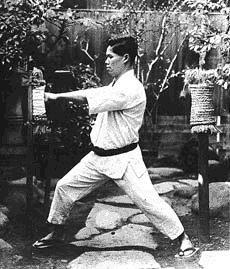 |
|
Master Funakoshi 3rd son Yoshitaka, renowned for his punching power practiced the makiwara daily |
|
 |
|
Master Mas Oyama trained and lived in the mountains of Japan |
|
 |
|
You must strike the makiwara with the first two strongest knuckles of the fist. You must not bend your wrist down or up. Always keep a direct level line with the middle knuckle that runs in the central line up the arm. A hip twist, a strong stance and proper breathing is very important. Energy transmitted by hitting the target is is known as rebound energy. This type of focused energy goes up through your arm down your body, down your rear leg hits solid ground which rebounds the energy back to the point of impact. This technique is called rebound return impact energy. The same return impact energy technique as you get from gel shock absorbing running shoes. |
|
 |
|
Push-ups on the knuckles strengthens the hand |
|
|
|
 |
|
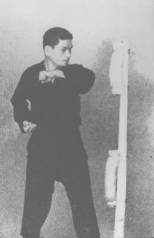 |
|
 |
|
 |
|
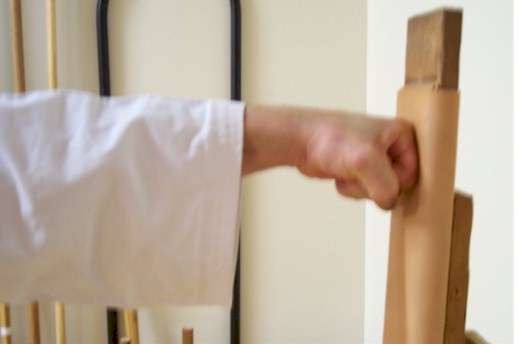 |
|
 |
|
 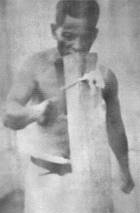 |
|
 |
|
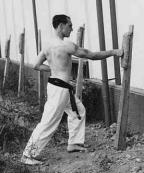 |
|
 |
|
 |
|
 |
|
 |
|
BREAKING DONE FROM TRAINING WITH THE MAKIWARA
|
|










